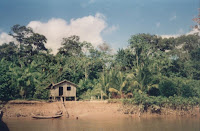 Steve Zwick in the Ecosystem Marketplace analyzes the issues involved in trying to prevent deforestation through the carbon markets. Long, but worth the read: European Commissioner for the Environment Stavros Dimas says he's all for saving the tropical rainforests, and has often lamented the fact that the destruction of this vital resource contributes about 20% of all greenhouse gas emissions worldwide.
Steve Zwick in the Ecosystem Marketplace analyzes the issues involved in trying to prevent deforestation through the carbon markets. Long, but worth the read: European Commissioner for the Environment Stavros Dimas says he's all for saving the tropical rainforests, and has often lamented the fact that the destruction of this vital resource contributes about 20% of all greenhouse gas emissions worldwide.He also says the European Union should do something to halt the loss, but draws the line at letting European industrial polluters pay for the capture of carbon in rainforests – at least when those payments are used to offset their own emissions (a concept called Reducing Emissions from Deforestation and Degradtion (REDD).
The European Council and European Parliament seem to agree. Each signed off on the European Union's climate and energy package in December. That package includes a commitment to develop "financing mechanisms" that will support the rainforests, but pointedly does not mention forestry offsets – in contrast to a proposal that the decidedly REDD-critical European Commission floated in October.
… Dimas and most of the people on his team fear that letting forestry credits into the EU ETS will flood the market for offsets, driving down prices and failing to create an incentive for industrial reductions within the European Union.
..."There is a lot of distrust of offsets in the Commission," he says. "And it is not just because of flooding; there are also concerns that those countries that will host REDD projects will not be able to manage leakage." He believes that risk management mechanisms – such applying a discount factor to allow for leakage or setting up buffer zones – will offset any leakage, but he also says many proponents of REDD under-estimate the capacity issues….
Deforestation in the Usambara Mountains in Lushoto District, Tanga Region, Tanzania. Shot by Mohsin S. Karmali, Wikimedia Commons






















_virion,_a_type_of_bird_flu_virus_which_is_a_subtype_of_avian_influenza_A.jpg)














